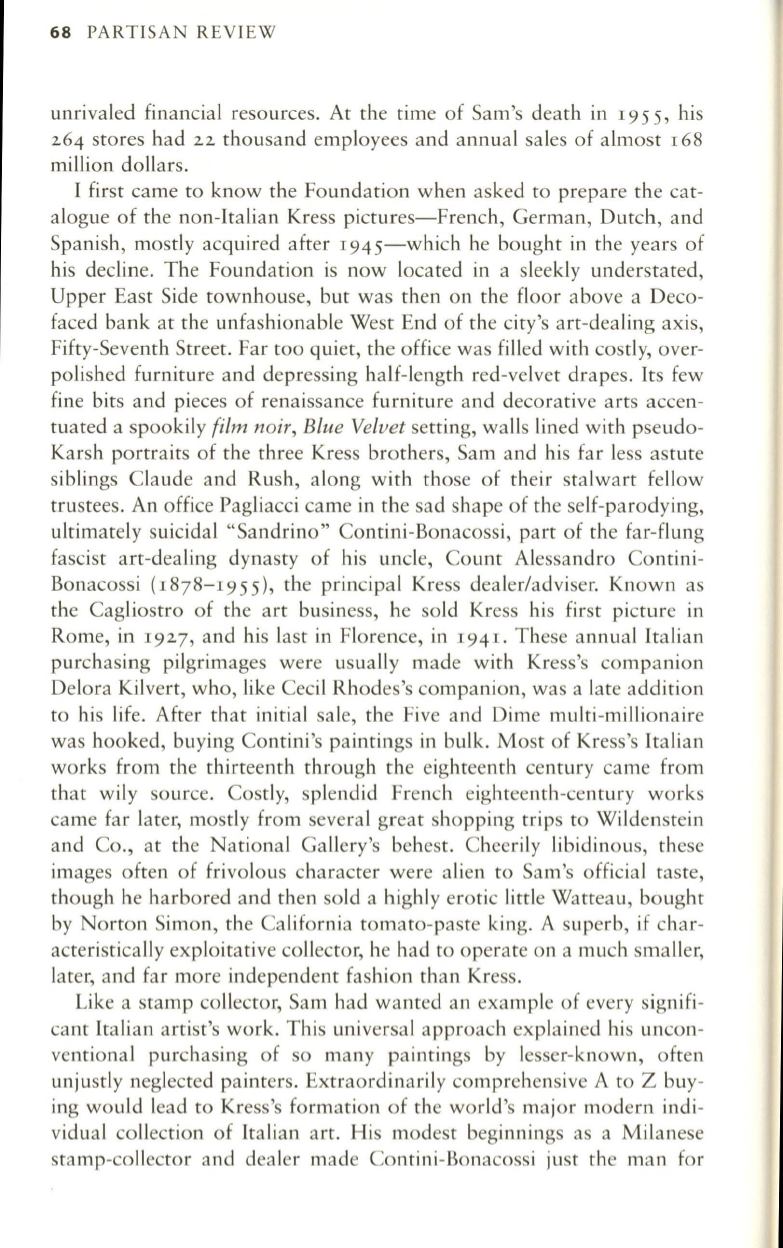
68
PARTISAN REVIEW
unrivaled financial resources. At the time of Sam's death in 1955, his
264 stores had 22 thousand employees and annual sales of almost 168
million dollars.
I first came to know the Foundation when asked to prepare the cat–
alogue of the non-Italian Kress pictures-French, German, Dutch, and
Spanish, mostly acquired after 1945-which he bought in the years of
his decline. The Foundation is now located in a sleekly understated,
Upper East Side townhouse, but was then on the floor above a Deco–
faced bank at the unfashionable West End of the city's art-dealing axis,
Fifty-Seventh Street. Far too quiet, the office was filled with costly, over–
polished furniture and depressing half-length red-velvet drapes. Its few
fine bits and pieces of renaissance furniture and decorative arts accen–
tuated a spookily
film noir, Blue Velvet
setting, walls lined with pseudo–
Karsh portraits of the three Kress brothers, Sam and his far less astute
siblings Claude and Rush, along with those of their stalwart fellow
trustees. An office Pagliacci came in the sad shape of the self-parodying,
ultimately suicidal "Sandrino" Contini-Bonacossi, part of the far-flung
fascist art-dealing dynasty of his uncle, Count Alessandro Contini–
Bonacossi (1878-1955), the principal Kress dealer/adviser. Known as
the Cagliostro of the art business, he sold Kress his first picture in
Rome, in 1927, and his last in Florence, in 194I. These annual Italian
purchasing pilgrimages were usually made with Kress's companion
Delora Kilvert, who, like Cecil Rhodes's companion, was a late addition
to his life. After that initial sale, the Five and Dime multi-millionaire
was hooked, buying Contini's paintings in bulk. Most of Kress's Italian
works from the thirteenth through the eighteenth century came from
that wily source. Costly, splendid French eighteenth-century works
came far later, mostly from several great shopping trips to Wildenstein
and Co., at the National Gallery'S behest. Cheerily libidinous, these
images often of frivolous character were alien to Sam's official taste,
though he harbored and then sold a highly erotic little Watteau, bought
by Norton Simon, the California tomato-paste king. A superb, if char–
acteristically exploitative collector, he had to operate on a much smaller,
later, and far more independent fashion than Kress.
Like a stamp collector, Sam had wanted an example of every signifi–
cant Italian artist's work. This universal approach explained his uncon–
ventional purchasing of so many paintings by lesser-known, often
unjustly neglected painters. Extraordinarily comprehensive A to Z buy–
ing would lead to Kress's formation of the world's major modern indi–
vidual collection of Italian art. His modest beginnings as a Milanese
stamp-collector and dealer made Contini-Bonacossi just the man for


